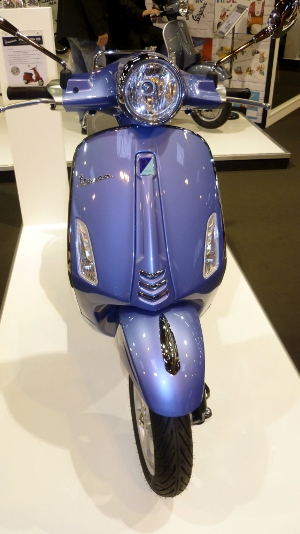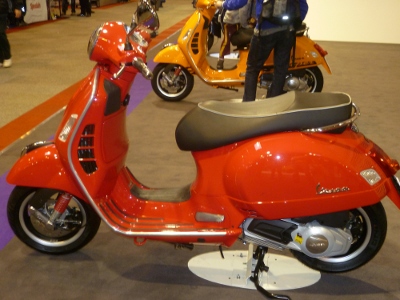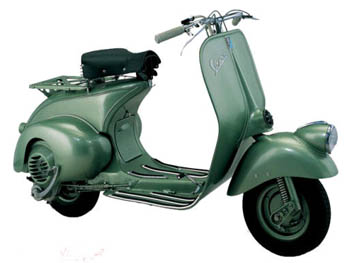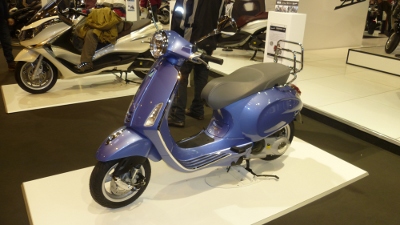The Vespa Scooter
It's the bike of the week!

2013 Vespa Primavera
"In the dock of Tiger Bay
On the road to Mandalay
From Bombay to Santa Fe
Over hills and far away..."
Anywhere you go in the world even in the most unlikely and far flung corners you may suddenly come across the ubiquitous, neat, dapper and cool little Vespa buzzing waspily about and getting its rider from A to B in a business like, efficient and groovy way.
Like many motorcycles and scooters worldwide the Vespa scooter owed its birth to the trauma and subsequent aftermath of the second world war. After the war many factories in Italy which had been involved in aviation or munitions had to shut down and a radical rethink was required. Out of the ashes of the razed factory buildings of Italy the Vespa eventually sprang phoenix like.
Due to a damaged economy and personal hard times a radical transport rethink was required and similar to Mr Honda's thinking in Japan, Enrico Piaggio, son of the founder of Piaggio, began looking around for some practical solutions. At that time there were a lot of US service personnel in Italy and one of their means of transport was the Cushman scooter. They used scooters to move quickly and subtley in order to out flank German positions and open up channels between the occupied countries.

So the ever present Cushman not only helped the war effort but served the dual purpose of making Italian transport designers have a lightbulb moment. One of these innovators was Ferdinando Innocenti who went into production with the Lambretta scooter, designed by Corradino D'Ascanio. D'Ascanio proposed the idea of the pressed steel frame for the new prototype scooter but Innocenti did not like this idea and went with a tubular frame as the central support with body parts attached. Sadly for Innocenti, D'Ascanio jumped ship and gave his design to Piaggio who was willing to stick more faithfully to his design.
1946 – the Vespa was born
The final design Vespa (meaning Wasp in Italian, named after the buzzing of the exhaust) went with was a spar frame with the petrol tank above the engine which used gravity to feed petrol down to the engine. The engine was rotary not chain driven allowing the gear mechanism to move between gears when the clutch was engaged.
The Vespa had a floorboard where the rider could put their feet which curved up into a windshield. The sides of the engine were covered as well but could be removed for repair but meanwhile the rider was protected from mud and rain splattering up. And an added bonus - Vespas were also great for women as they could easily ride with skirts on.
The original Vespa had a throttle and front brake lever and handlebar shift on the left to control the gear shift with steel cables attached, activated by a clutch lever. The PX range still has this arrangement today.
Underneath the scooter was reinforced with additional metal straps which meant that it was really strong and wouldn't bend in the middle.
The battle was on between the Vespa and the Lambretta, but Piaggio won and the first Vespa rolled off the production line in April 1946 a year before Lambretta made it onto the street.
What went where
The early Vespa was very true to D'Ascanio's design with various personal touches the buyer could choose, if buying it from new, for example a pillion seat or a luggage rack on the back depending on what suited their lifestyle.
The petrol tank was located under the seat and the driver had to add oil to the tank to make sure that the engine was well lubricated.
The Vespa had small wheels – eight inches – this made it easy to maneuver in tight spots which in turn made it eminently suitable for town riding and negotiating traffic – something which would stand it in good stead as it moved through time into the modern congested world we live in today. It's gear system was also great for town riding with three gears in total two for starting up and driving slowly and one for cruising when a good speed had been reached.
The Vespa engine was a workhorse which was stronger than the competition at the time, it was 98cc two stroke cylinder design. The engine was air cooled but fins were soon added to the flywheel to make this more effective by forcing air onto the cylinder.
So the first thirteen scooters rolled off the production line which was evolving all the time from a workshop into a factory eventually acquiring machinery to up production. And as for the Vespa marketing strategy – it was simple just show people the Vespa and they’d be guaranteed to want one – of course it worked.
The Vespa appeared at the Milan show in 1946 which upped its popularity so its production went up to a mind blowing 54!! But from then on it went from strength to strength until by the end of the first year of production it stood at around 2,500 units and gradually increased production until by 1949 60,000 were made – a pretty meteoric rise to fame.
The film Roman Holiday helped and increased sales exponentially after Audrey Hepburn and Gregory Peck rode coolly and romantically around Rome on one – everyone wanted to be them and a Vespa would help! Vespa sold 100,000 scooters.
1950s
Piaggio opened factories in Germany and the UK and Vespa production spread until they were being manufactured in thirteen countries
1960
In 1960 Vespa started selling in Asia and Brazil where their were a lot of people without much money who needed nippy cheap transport to get around on – a practical solution. The UK had become Vespa’s biggest target market by this time due to their popularity with Mods.
1970
By the 70s four million were in production and by the end of the 70s it had risen to ten million – what a success story.
1990s
However things then began to take a turn for the worse and, despite a mod revival in the UK, by the 1990s Vespa sales had plummeted compared to previous decades being replaced by cheaper copies in many countries. It was time for Piaggio to have a radical rethink and bring out something
fresh which would captivate another generation. After due consideration of this question the ET line of Vespas was born. The ET was lighter than its predecessors, had changeable engine sizes and a four stroke engine to cope with the new emissions regulations which were killing it off in for example the US. The transmission went automatic but the old Vespa shape remained intact.
2001
The strategy worked and Vespa was once again allowed to grace the streets of America in 2001 appearing as a new vehicle.
2003
Despite its rescue package Vespa was still in trouble though and found itself bankrupt by 2003. After a rescue involving taking the factories back to efficient production methods the new Vespa hit the button for the new market and became a favourite yet again around town for trendy young things.
Vespa broadened the market as consumer interest grew until today the Vespa is available in the LX and GTS range which gives options from a 50cc basic scooter to highway-capable Vespa 300cc GTS Super model with effortless pillion capability.
So with a long pedigree and a bumpy road to traverse at times, the Vespa is living a long and fulfilling life, gracing Milan and Motorcycle Live this year in a new form as the reborn Primavera.
The new Primavera still has features from the 946. It maintains the classic single arm suspension beloved of Vespa, but has an all new system for reducing slide friction. The shock is now fixed to the support which is attached to the wheel with a hinged pin. It comes as a two stroke or a four stroke engine. The two stroke is designed for performance and the four stroke has four valve timing. The 125 and 150cc versions have a modern three valve engine.
The Vespa remains a perennial favourite and a much loved symbol of cool and as I said at the beginning of this article, due to its popularity and historically its world wide production you may happen upon one anywhere in the world – listen for the sound of a wasp...
In the deserts of Sudan
And the gardens of Japan
From Milan to Yucatan
Every woman, every man...
may be seen...Audrey Hepburn/Gregory Peck stylie...buzzin' round on a Vespa
Wemoto
Anyone had one? Anyone love Vespas? Let us know on
[email protected] or drop us a comment on facebook






